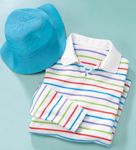- Case-Based Roundtable
- General Dermatology
- Eczema
- Chronic Hand Eczema
- Alopecia
- Aesthetics
- Vitiligo
- COVID-19
- Actinic Keratosis
- Precision Medicine and Biologics
- Rare Disease
- Wound Care
- Rosacea
- Psoriasis
- Psoriatic Arthritis
- Atopic Dermatitis
- Melasma
- NP and PA
- Skin Cancer
- Hidradenitis Suppurativa
- Drug Watch
- Pigmentary Disorders
- Acne
- Pediatric Dermatology
- Practice Management
- Prurigo Nodularis
- Buy-and-Bill
Article
Garments on guard
Garments can be a very effective sun protection device. However, there are both advantages and disadvantages when compared with sunscreen. Understanding and disseminating information on what's out there is key to effective garment use.

Key Points
National report - Sun-protective clothing can help prevent sun damage by providing all-day, carefree coverage from the sun.

"I recommend sun-protective clothing to all my patients. Currently, there is no regulation of this clothing in the United States," says Dr. Draelos, who is also a primary investigator, Dermatology Consulting Services, High Point, N.C., and a Dermatology Times adviser.
"Any light that is seen is striking the skin. The denser the weave, the better sun protection provided," she says.
"You can use any type of clothing as sun-protective. It does not need to come from a special manufacturer," she adds.
Australia was the first country to develop official standards for sun-protective clothing and the Ultraviolet Protection Factor (UPF) garment rating system.
According to the Standards Association of Australia, "sun-protective clothing" includes items of personal apparel (including garments, hats, shoes and fabric intended to be made into personal apparel) that carry a claim of protective advantage against solar ultraviolet (UV) radiation.
UV protection

"Therefore, fabric slows sunburning, the development of cancerous skin lesions and premature aging of the skin," Dr. Hatch says.
"Using cover-up garments and sunscreen lotions is an effective combination for protection of the skin while outdoors on sunny or cloudy days," she says, noting that people can learn about how fabrics provide UV protection and then select garments that provide the protection according to their needs and budget.
"There are really two classifications of garments from which consumers can choose for clothing for solar UV protection," she explains.
"The first classification contains those garments sold in the marketplace with a claim about UV protection (usually called UV-protective clothing). The second classification contains those garments worn that offer UV protection, but it is up to the consumer to 'assess' what degree of protection is afforded by the garment's fabric. Wearing garment styles that cover the skin is essential."
When a manufacturer makes a claim that the garment is UV-protective, it usually tests and labels the garment using a standard procedure, often one developed by a committee within a national, regional or international standard setting organization, she says.
Specialty manufacturers
Many companies, including Coolibar, No Zone and Solar Gear LLC, among others, specialize in sun-protective clothing, and other manufacturers, such as Nike, Adidas and LLBean, produce selected styles that offer sun protection.
"The most effective means of protecting against the sun is a combination of sun-protective clothing (including tops, bottoms and hats), sunscreen and shade," says John Barrow, president of Coolibar, a sun-protective clothing company in Minneapolis.
"While there are certain groups of people for whom sun protection is more important, such as those with a family history of problems with the sun, I believe this combination approach is the best for everyone."
Mr. Barrow offers several tips for guiding consumers as they shop for protective clothing.





